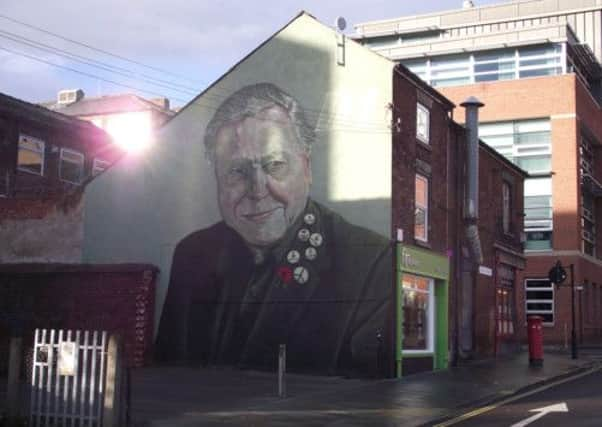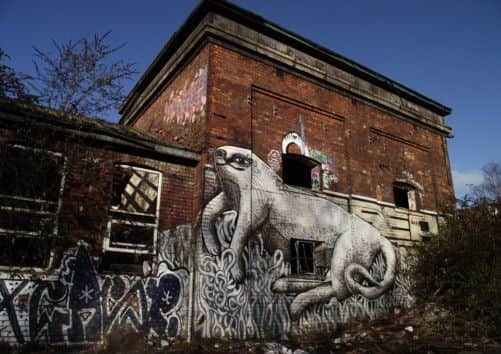Chasing artists who bring life to city walls


Dave Surridge admits that in a world whose leading lights are called Phlegm, Rocket01, coLor and Kid Acne he might be seen as a little too conventional.
Aside from the sensible, solid name, he’s also the other side of middle-age, a few pounds over his ideal weight and a senior lecturer in sociology.
Advertisement
Hide AdAdvertisement
Hide AdIn fact his only vaguely urban credential is that in a previous life he was a bricklayer.


However, while he might lack an eye-catching pseudonym, Dave has become something of an expert in street art and when not lecturing undergraduates at Sheffield Hallam University, spends much of his spare time in search of examples of the city’s burgeoning scene.
While Banksy was busy monopolising the coverage of guerilla art, Sheffield has quietly emerged as a hub for the kind of artists who prefer brick walls and derelict factory buildings to anything approaching a traditional gallery.
Often operating at night and in the kind of places which attract few passers-by, their work is not easily accessible and over the last few years Dave has found himself in a few compromising positions as he attempts to record the work of this group of anonymous artists for posterity.
Advertisement
Hide AdAdvertisement
Hide Ad“I’ve found myself scrambling over piles or rubble and scaling 7ft walls just to get into some of these derelict buildings,” he says.
“There’s an old brickworks where I caught myself hanging through a half-open window, thinking, ‘What the hell are you doing? You’re 56 years old, you’re overweight, you’re unhealthy’, but knowing these are places you’re not supposed to be is part of the attraction.
“One minute you are standing in front of some tumbledown building; the next you’re in front of some incredible work of art. Once I noticed one mural, I started seeing them everywhere and to be honest I have become quite obsessed with it.”
It’s not just Dave. Dozens of blogs are now dedicated to the work of Sheffield’s street artists, Kid Acne has been known to run masterclasses for other upcoming artists.
Advertisement
Hide AdAdvertisement
Hide AdThere’s even an interactive online map for those who want to see the work, but would rather not get their shoes dirty.
A similar scene has been operating for a while now in Bristol, but Sheffield seems to have attracted artists from outside of the city.
Kid Acne, who grew up in Loughborough, moved north for university, Phlegm hails from Wales and coLor swapped Hebden Bridge for Steel City, presumably because large factory walls make better canvases than Yorkshire stone cottages.
However, while this disparate community of artists may have piqued the interest of their peers and academics like Dave – last year an online petition even called for the restoration of one of Kid Acne’s huge slogans created on Eyre Street after the panels had been partially obscured – street art still suffers from an image problem.
Advertisement
Hide AdAdvertisement
Hide AdWhile some of Sheffield’s most prominent artists have won commissions to transform corners of the city, many operate illegally and without the permission of the building’s owner.
“I think we have to draw a line between three very distinct groups. First there are the taggers whose aim is to daub their symbol on as many parts of the city as possible. For them it’s just a numbers game and their work is unsophisticated. At the next level are ‘throw-ups’ which is less about the art and more about scaling buildings and getting your work as high as possible.
“Then there are the real artists, the best of which incorporate elements of the building into the design, like old fuse boxes and beams, which makes the work three dimensional. One of my favourite pieces is in a burnt-out country club on the edge of Sheffield. The squash court was covered in soot and the artist used the ash to create a really startling black and white paint effect.
“I know some people won’t thank me for saying it, but one of the attractions of Sheffield for these artists is that there are a lot of derelict buildings. It’s a grey rather than blank canvas.
Advertisement
Hide AdAdvertisement
Hide Ad“When you’ve got work of real calibre it not only brightens up an area of the city, but it also provokes a reaction. I understand that people might not like it, but I’d like to think they might appreciate that it’s something a little different, something which challenges the usual urban humdrum.
“In some places like Bologna, the street art is very political, but it’s much less so here. That’s one of the reasons why I started this project. It was about giving these artists who leave their mark on steel shutters and the sides of pubs a voice because I think what they have to say is important. Cities like Manchester and Leeds have always been very good at self-promotion. Sheffield hasn’t and maybe the street art is a reaction against that.”
While the obscure locations of much of Sheffield’s street art are partly practical – the more hidden from view, the less likely they are to get caught – for many of the artists, the backdrop is as important as the final image.
“Some of the artists have a shopping list of places they want to paint on, whether it be rusty old grain silos or inside or the side of a cooling tower,” says Dave. “They also have a completely different mindset to a traditional artists. Once they do a piece, more often than not they walk away from it and leave it to those skilled in photography to record the image. I’m constantly revisiting sites and you see work going through a process of deterioration. There’s never any attempt to freshen it up, once it’s done, that’s it, they move onto something else.
Advertisement
Hide AdAdvertisement
Hide Ad“All of which begs the question, why invest so much time and energy in something that only a handful of people might see?”
It’s one Dave hopes to answer by gaining the trust of the street art community and that might be easier than it would have been a few years ago.
While they have been largely anonymous, the fame of the Sheffield artists is growing. Rocket01 was recently commissioned to paint detailed murals of scientist Charles Darwin and broadcaster David Attenborough and while only a small minority can make a living as street artists, the city’s most successful have worked everywhere from Cape Verde islands to Prague and Croatia.
“Someone like Phlegm is interesting. A few years ago he was selling prints of his work for £20,” says Dave. “Now they are going for £400. They tend to leave the promotion to others, but once they get a bit of a following word soon gets round. Of course the problem is that part of being a street artist is about operating on the edge of society, but as their work gains recognition it’s inevitable that they are embraced by the mainstream.”
And by academics like Dave.
Taking ownership of street art
Advertisement
Hide AdAdvertisement
Hide AdIf proof were needed about the rising interest in street art, it was helpfully provided a few weeks ago by Banksy.
Last month his 2009 mural of a boy hunched over a sewing maching making Union Jack bunting disappeared from the side of a discount shop in Haringey and reappeared in a Miami auction house. However, the work, valued at up to £450,000, was eventually withdrawn from the sale following protests by the local community. Not that Dave Surridge would have been tempted to put in a bid.
“For a man of mystery, Banksy’s a pretty decent self-publicist,” he says. “He’s done well for himself, but I’m not a fan. I prefer work that’s a bit more complex.”